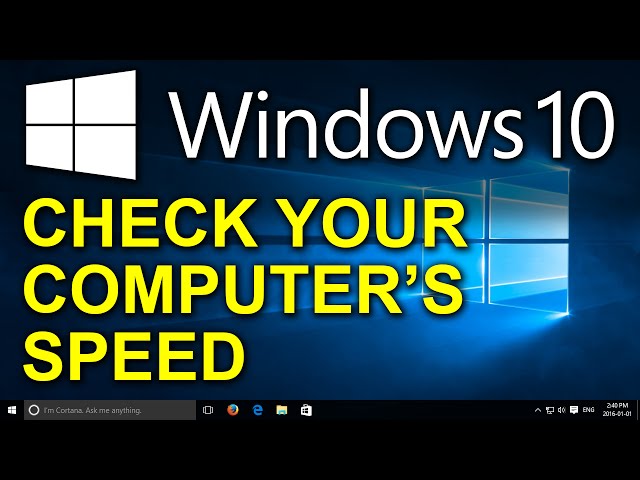Unveiling the Power: A Comprehensive Guide on How to Check Your Computer Performance on Windows 10

Introduction:
Windows 10, the flagship operating system from Microsoft, empowers users with a host of tools and features to assess and monitor the performance of their computers. Whether you’re a power user, a gamer, or simply someone curious about the inner workings of your machine, understanding how to check your computer’s performance on Windows 10 is essential. This comprehensive guide will delve into various built-in and third-party tools, providing an in-depth exploration of the metrics and insights you need to evaluate your computer’s capabilities and identify potential areas for improvement.
Built-in Methods for Monitoring Performance:
Method 1: Task Manager
- Access Task Manager:
- Right-click on the taskbar and select “Task Manager” or press
Ctrl + Shift + Escto open Task Manager directly.
- Right-click on the taskbar and select “Task Manager” or press
- Performance Tab:
- Navigate to the “Performance” tab in Task Manager to view real-time graphs of CPU, Memory, Disk, Ethernet, and GPU usage.
- Processes Tab:
- Explore the “Processes” tab to see detailed information about individual processes and their resource consumption.
- Startup Impact:
- Check the “Startup” tab to assess the impact of startup programs on your system’s performance.
Method 2: Resource Monitor
- Access Resource Monitor:
- In Task Manager, click on the “Performance” tab and then the “Open Resource Monitor” link at the bottom.
- Comprehensive Performance Metrics:
- Resource Monitor provides detailed information on CPU, Memory, Disk, Network, and more. Navigate through the tabs to analyze specific aspects of your system’s performance.
Method 3: Windows Performance Monitor
- Open Performance Monitor:
- Press
Win + R, type “perfmon,” and press Enter to open the Performance Monitor.
- Press
- Monitor Specific Metrics:
- Customize your monitoring experience by selecting specific performance counters and creating a personalized performance monitoring workspace.
Advanced Performance Assessment:
Method 4: Windows Reliability Monitor
- Access Reliability Monitor:
- Press
Win + R, type “perfmon /rel,” and press Enter to open the Reliability Monitor.
- Press
- Visualize System Reliability:
- Reliability Monitor provides a timeline of system events and issues, offering insights into the stability and reliability of your computer.
Method 5: Windows Experience Index (Deprecated)
- Open Command Prompt:
- Press
Win + Xand choose “Command Prompt (Admin)” or “Windows PowerShell (Admin).”
- Press
- Check Experience Index:
- Type “winsat formal” and press Enter to run the Windows System Assessment Tool. Although officially deprecated, some users may still find it relevant for a basic assessment.
Third-Party Performance Monitoring Tools:
Method 6: HWiNFO
- Download and Install HWiNFO:
- Visit the official HWiNFO website (https://www.hwinfo.com/) to download and install the tool.
- Explore Real-Time Data:
- HWiNFO provides detailed real-time information about hardware components, temperatures, voltages, and more.
Method 7: MSI Afterburner
- Download and Install MSI Afterburner:
- Visit the MSI Afterburner website (https://www.msi.com/Landing/afterburner) to download and install the tool.
- Monitor GPU Performance:
- Primarily designed for GPU monitoring, MSI Afterburner offers real-time data on GPU usage, temperature, and fan speed.
Tips for a Comprehensive Performance Analysis:
- Regular Monitoring:
- Regularly check your computer’s performance to identify patterns or anomalies that may indicate hardware or software issues.
- Consider Real-Time Monitoring:
- Real-time monitoring tools, like Task Manager and Resource Monitor, are invaluable for identifying performance bottlenecks as they occur.
- Use Benchmarking Tools:
- Explore benchmarking tools, such as UserBenchmark or Cinebench, to assess your computer’s performance against industry standards.
- Check for Driver Updates:
- Ensure that your device drivers are up-to-date, as outdated drivers can impact performance.
- Optimize Startup Programs:
- Review and optimize your startup programs using Task Manager to improve boot times and overall system responsiveness.
- Keep Your System Clean:
- Regularly perform maintenance tasks like disk cleanup and defragmentation to keep your system running efficiently.
Conclusion:
Checking your computer’s performance on Windows 10 is a multi-faceted process, involving a combination of built-in tools and third-party applications. Whether you’re a casual user interested in basic metrics or an enthusiast seeking granular insights, the methods explored in this guide cater to a diverse range of needs. Embrace the power of knowledge by regularly monitoring your computer’s performance, identifying areas for improvement, and taking proactive steps to optimize your system for an efficient and enjoyable computing experience.







